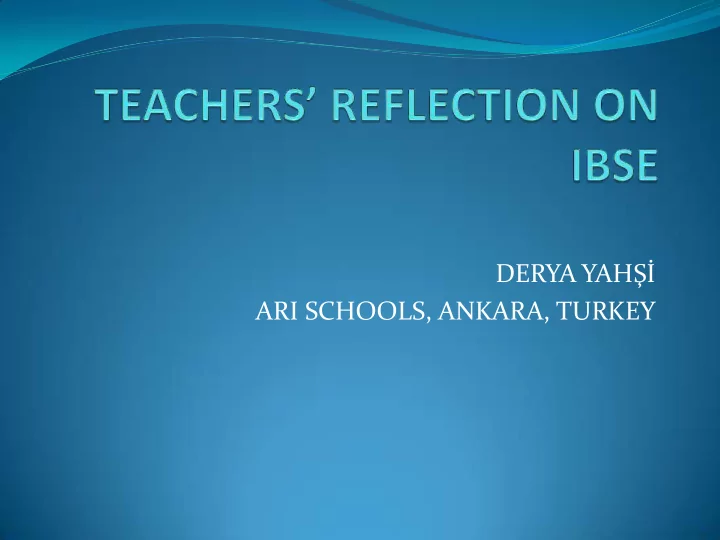

DERYA YAHŞİ ARI SCHOOLS, ANKARA, TURKEY
Last year, we started this project in our college. We are guided by Hacettepe University during our meetings which we did every two weeks. Basicly, our meetings were about ; discuss the problems of the inquiry based learning, try to find possible practicle solutions and possible feedback from the class.
The first week we taught the students how to developed questions for inquiry. Target question should start with ‘ how ’ but not ‘ why ’. In inquiry question with ‘ how ’ is more suitable than ‘ why ’ question.
Second week was about the developing the hypothesis . We didn’t face with any problem at this step. Students understood easily basic of the hypothesis.
Third week was about the identifying variables. It was most diffucult step for students. We spent three to four weeks on this step. Especially students couldn’t seperate dependent variable and independent variable. For this reason, we did more practices on this step.
Afterwards we recorded and interpreted our data. The way of implementing of inquiry based learning, we assessed our students by : short quizzes, question and answer, discussions. We tried to apply rubric but it didn’t work, because of the lack of time and number of students.
SAILS TEACHERS’ WORKSHOP
I also did SAILS workshops in Ankara. All the teachers who joined this workshop were from public schools. I divided teachers in groups and did the same practice as I did in my class with my students.
Later, I discussed this strategy together with them. They suggested that you can implement this strategy with small groups, it can be harder with larger groups.
A SAILS ACTIVITY : ELECTRICITY I did this activity with 16-6th grade students. I started the lesson with asking some questions to students. For example ; * What do we need to be able to see? * Are there any other ways helping in moving around when one is not able to see?
Students answered questions while I gave some feedback. The feedback was in the form of asking other questions. I tried to refrain from giving a correct answer to let students express their opinions without being influenced by me. I said to students a few times , ‘Ok. I won’t make any comment now; we will talk more about it later .’ After the question-answer part and discussions, I distribute worksheets to students. I asked them to draw a mind map about electricity.
However, I didn’t talk about it detail. In only few minutes, students draw a mind map on the worksheet, than I asked them to share in front of the class what they have drawn. Students just listed the concepts that they have written down. Then I asked students to find scientific and daily language words related to electricity. Students gave examples like buton vs circuit switch, dial buton vs. rheostat, lamp wire vs. tungsten. In addition they talked about the meaning of words in their concepts.
Activity worksheet
I asked to students to formulate a research question which includes ‘ how ’ first. Before the next section of unit, I asked students to put the materials that they brought to the class on the table and write their predictions (hypotheses) about materials ’ conductivity.
In the third part of the unit, students are expected to set up a simple electric circuit. Firstly I wanted students to draw a working simple circuit.Then I asked students to list the vital components of the circuit . Some students said , “ lamp holder, circuit key, wires, etc .” Students seemed to know about how to set up a simple circuit.
I gave a worksheet about the inquiry activity of the unit. Students tried to add different objects to the circuit (such as hair comb, cooking pot, piece of wood, salty water, lemon, lemon juice, silver ring, pencil graphite, different metals, etc.) that they brought to the class and they predicted the brightness of the lamp in the circuit. First they wrote their predictions to the table given by me and then they made observations.
Students had different predictions about the pencil graphite. They tried it and observed that the brightness of the lamp was less than metals but more than salty water. After their observations, students classified objects into three groups as conductors, semi-conductors and non-conductors. The class time ended after this activity.
How were the skills assessed? I assessed student knowledge by using question- answer sessions. There were rubrics suggested in the unit about certain inquiry skills, but I did not use them during the class. Question-answer sessions seemed as a rapid way of collecting information from students. In my opinion it would be difficult to use rubrics during the class. They could be used after the class based on student products or classroom observations.
THANK YOU..
Recommend
More recommend